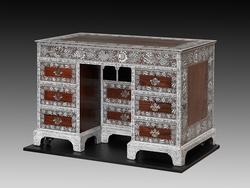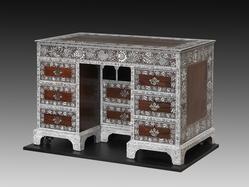Current Location: In storage
Maker(s)
Maker:
Unknown
Entities
Categories
Description
Anglo-Indian desk of rosewood inlaid with ivory, with silver handles
Notes
History note: Sir Thomas Rumbold, 1st baronet (1736-91), Governor of Madras from 1777-80. On loan to the Fitzwilliam Museum since 2012.
Legal notes
Accepted by H.M. Government in lieu of inheritance tax, from the estate of Elizabeth Anne Chubb, Lady Hayter
Measurements and weight
Depth: 62 cm
Height: 76 cm
Width: 113 cm
Acquisition and important dates
Method of acquisition: Allocated
(2016)
by
H.M. Government
Dating
18th Century, Mid
Circa
1750
CE
-
1760
CE
Note
Although the identities of the Indian craftsmen who made this desk are unknown, we know that it was once owned by the notoriously corrupt British politician and colonial administrator Sir Thomas Rumbold, 1st baronet (1736–91), who was a Director of the East India Company and Governor of Madras (1777–80) before being accused of huge fraud. In the 18th century, these inlaid pieces of furniture from Visakhapatnam were sought after by discerning collectors: Viscount Fitzwilliam (the Museum’s founder) owned a Visakhapatnam bookcase, now in the Peabody Museum, Salem (USA).
From around 1683, Visakhapatnam, a port on India’s east coast, became a centre for the manufacture of 'Anglo-Indian' furniture and textiles made for export to Europe. It is likely that British colonial forces sent British designers to India to teach Indian craftsmen how to apply their traditional ivory-working skills to the production of high-quality furniture of traditional European form. Here, a kneehole desk, a form developed in England in the early 18th century, is decorated with complex ivory inlay, the floral patterns based on Indian plants. They are similar to those found on ‘chintz’ fabrics exported to Europe at the same time.
School or Style
Anglo-Indian
Components of the work
Handles
composed of
silver
Inlay
composed of
ivory
Ivory
Materials used in production
Rosewood
References and bibliographic entries
Identification numbers
Accession number: M.3-2016
Primary reference Number: 208433
Old loan number: AAL.1-2012
Entry form number: 1061
Stable URI
Audit data
Created: Thursday 17 March 2016
Updated: Thursday 10 August 2023
Last processed: Tuesday 13 May 2025
Associated departments & institutions
Owner or interested party:
The Fitzwilliam Museum
Associated department:
Applied Arts

 IIIF Manifest
IIIF Manifest








